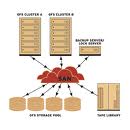Distributed File Systems (DFS) have emerged as sophisticated solutions for efficient file storage and management across interconnected computer nodes. The main objective of DFS is to achieve flexible, scalable, and resilient file storage management by dispersing file data across multiple interconnected computer nodes, enabling users to seamlessly access and manipulate files distributed across diverse nodes. This article provides an overview of DFS, its architecture, classification methods, design considerations, challenges, and common implementations. Common DFS implementations discussed include NFS, AFS, GFS, HDFS, and CephFS, each tailored to specific use cases and design goals. Understanding the nuances of DFS architecture, classification, and design considerations is crucial for developing efficient, stable, and secure distributed file systems to meet diverse user and application needs in modern computing environments.
翻译:暂无翻译





